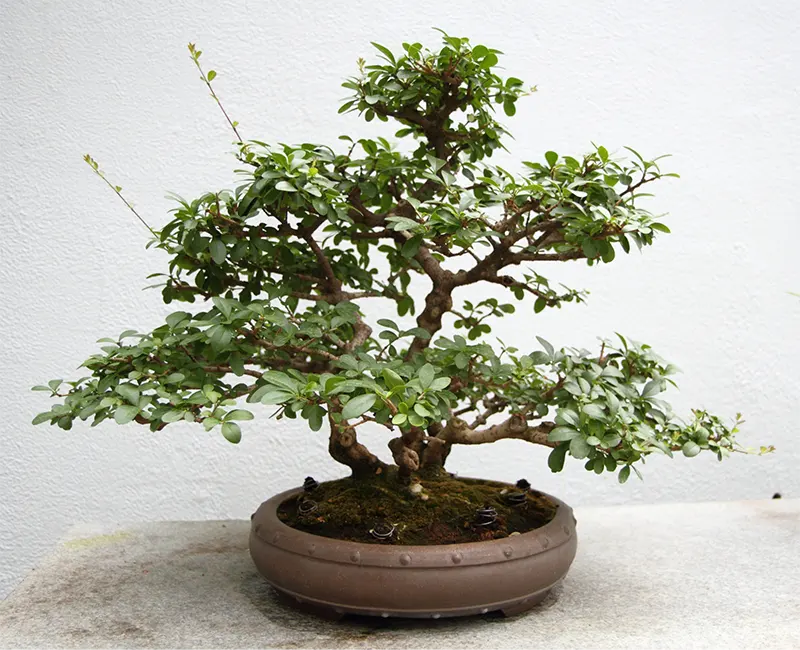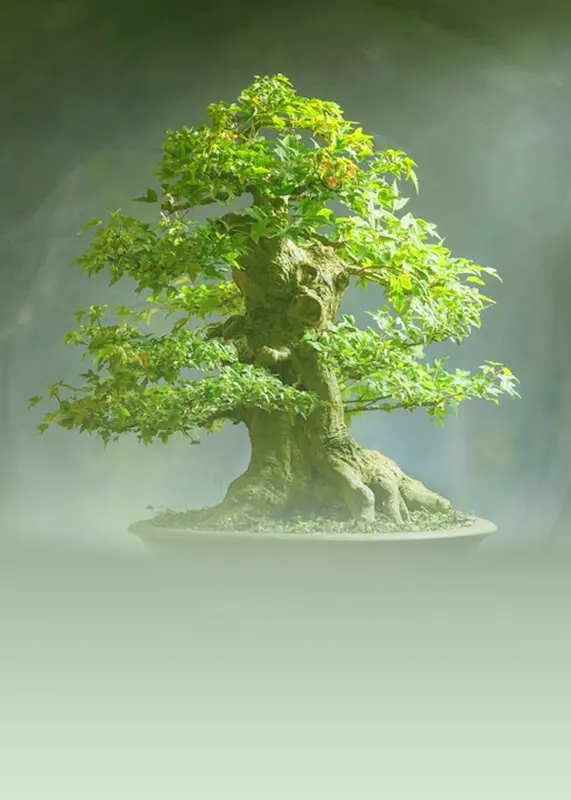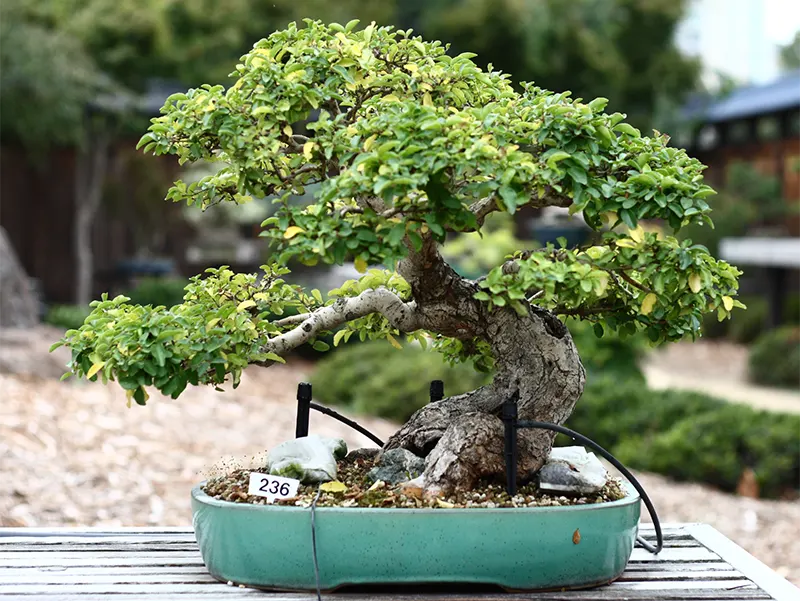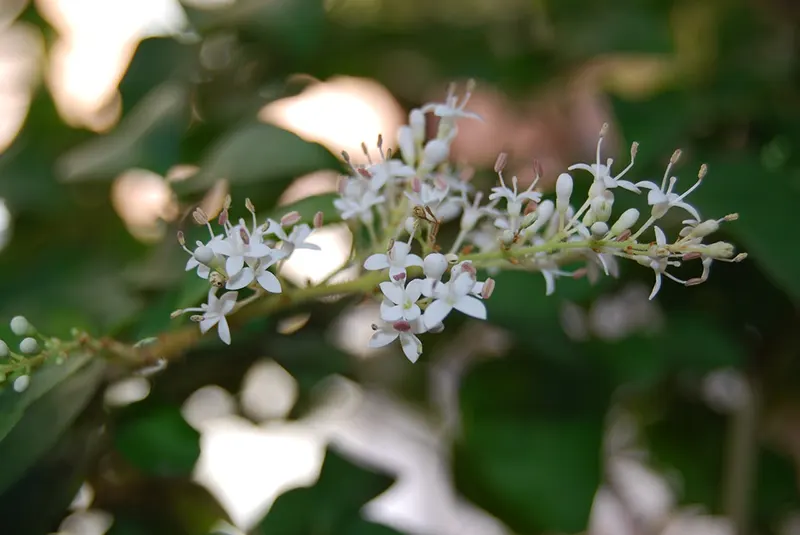Recurve Ligustrum Bonsai Care Guide
Ligustrum Japonica ‘Recurvifolium’
Recurve Ligustrum is a privet tree that belongs to the olive family. The evergreen bonsai has dark green leaves with a glossy exterior loved by many. In summer, it produces small white flowers in clusters that fill the foliage. When pollinated, they produce drupe fruits that won’t burden your small tree.
Ligustrum japonicum ‘Recurvifolium’ is native to Japan, which is why it’s also called Japanese privet. While it also grows well in Korea, many people cultivate it in California and other parts of the United States. The fruit can be used as a herbal medicine when prepared correctly.
Image courtesy of Cephas | Licence details
Here’s what you’ll find in our Recurve Ligustrum Bonsai species guide:
Here’s what you’ll find in our Recurve Ligustrum Bonsai species guide:
01
02
03
04
05
06
Quick Recurve Ligustrum Bonsai Care Sheet
For a quick summary of the basics to care for your Recurve Ligustrum Bonsai, see the care sheet below.
Recommended soil
Standard mix with a slightly alkaline pH (8.0)
Watering
Water as needed, checking when the top 3 inches of soil becomes dry. Can tolerate dry conditions when mature
Potting season
Every two to three seasons just before the spring leaves appear
Shaping and pruning season
Trim in summer if you want flowers, with design pruning in winter. Can handle wiring
Light
Can manage with both full and partial light, and suitable for outdoors and indoors
Fertilizing
Early spring with slow-release fertilizers
Propagation methods
Cuttings, air-layering, seeds
Pests and diseases
Aphids, whiteflies, weevils, scale, wilt, mildew
Growth patterns
Fast growing with wild shoots you’ll need to maintain
Recommended styles
Most styles, such as informal, formal, root-over-rock, literati, cascade, rail, and forest
Scientific Classification
- Kingdom: Plantae
- Clade: Angiosperms
- Division: Eudicots
- Class: Asterids
- Order: Lamiales
- Family: Oleaceae
- Genus: Ligustrum
- Species: L. japonicum
- Cultivar: ‘Recurvifolium’
How to Care for a Recurve Ligustrum Bonsai
Looking after your Recurve Ligustrum bonsai has the same general principles as most privet trees in a pot. There are some factors that are slightly different, but it’s a hardy species that’s easy to maintain. Here are the basic guidelines to follow, or take a look at our more extensive bonsai tree care article.
Best Soil
You can buy a local bonsai soil mix from your local store, and the Recurve Ligustrum will be satisfied. You need to ensure that there’s proper drainage, so it won’t hurt to add some drainage stones at the bottom. As long as the structure and roots are secure when you plant it, the bonsai should remain healthy for a long time.

One element to mention is that it’s one of the bonsai trees that like alkaline soil more than acidic. It’s fine if the pH level is balanced, but it will grow better if the level is at about 8. If you’re obsessive about having everything perfect, measure the pH level with a tool and then make any necessary adjustments.
Watering
When the Recurve Ligustrum bonsai is mature, it’s happy to live in drought conditions with watering once or twice a week, even in summer. If you’re starting with a 2 week old seedling, it will need water more regularly, possibly daily in the warmer seasons. The trick is to feel how dry the top 3 inches of soil is.
Autumn and winter will see the tree slow down on drinking. You won’t really need to water unless the soil goes completely dry. When frost arrives, you’ll find the soil remains damp anyway, so steer away from causing mold or root rot.
Repotting
As a youngling, you’ll need to repot the Recurve Ligustrum every two years. The roots grow quickly, which means they will end up suffocating when they run out of space in the bonsai pot. Aim to transplant at the end of winter when the frost or cold starts to vanish.
Older Recurve Ligustrum bonsai trees grow a bit more slowly, which means you can wait three to four years. Make sure you check the soil to see if there are too many roots, providing an indication that you need to change the substrate. You can also see if any roots are extending past the drainage holes.
Shaping and Pruning
With how wild the Recurve Ligustrum grows, you may be tempted to prune in spring. The shoots grow as quickly as olive trees, which means the foliage will be out of shape. We recommend you wait until summer. Any pruning done in spring will mean the bonsai won’t grow flowers in summer.
If you’re more concerned about the shape than flowers, you can prune back to the desired lengths. Many people look at the shape of the pot to keep the same design in the foliage. Of course, it depends on which style you went for. Winter is the best time to work on the design without any new growths disturbing you.
Location and Sunlight
As with most privet trees, the Recurve Ligustrum loves direct sunlight for three to four hours a day. Therefore, you can easily place it outside for most of the year while bringing it in when frost arrives in winter. It can also handle dappled shade if you have a cloth over your bonsais.
If you prefer having your bonsais inside, the Recurve Ligustrum has no issues with that. As long as there’s direct or indirect sunlight in some form so it can perform photosynthesis, it will happily grow in your home.
Fertilizing
While your Recurve Ligustrum will benefit from fertilizer, you’ll want the slow-release types. It doesn’t handle the liquid forms too well, preferring to take its time in absorbing the nutrients. Look for food spikes or pellets with a balanced NPK value to encourage the development of leaves, flowers, and seeds.
You can start feeding in spring, and then again in summer, as the spikes should last an entire season. You can also supply a bit at the start of autumn so it can store carbohydrates for the upcoming winter. Whatever you do, let it rest when winter does appear.
Propagation Methods
The most popular method of propagating Recurve Ligustrum is via cuttings. They take easily with root hormone powder and bonsai soil. You can also try air-layering with semi-hardwood branches, which has proven successful among many beginners and experts.
You’re more than welcome to try propagating the privet seeds, but it takes a long time to germinate and grow them into young bonsai trees. Also, the chances of success aren’t as good as with cuttings. However, don’t let that stop you from at least trying to see if you can get it right.
Pests and Diseases
Fortunately, Recurve Ligustrum is quite resilient against pests, even when grown outsides. If you keep the area clean and filled with sunshine, you shouldn’t have too many issues. The pests that love this species include aphids, whiteflies, weevils, and scales. Usually, you’ll find issues with them when the flowers appear.
The bonsai should also be strong against mold and other diseases. If you have good drainage, you won’t really encounter root rot problems. However, watch out for leaf wilt from under- or over-watering. Since it’s an evergreen, the leaves shouldn’t really be falling off or changing color.
Growth Patterns
Privet trees generally grow like bushes in the wild. Yes, they can reach tall heights, but many owners shape them like bushes. Your bonsai will also develop wildly, so it’s up to you if you want it to look like a small bush. Spring sees plenty of new shoots, while summer shows off with a flower display.
The Recurve Ligustrum grows about 25 inches per year, which gives you an idea of how much foliage you’ll see in spring and summer. It’s up to you how big you want your bonsai to develop, as long as it doesn’t look like a fully-grown tree taking up all the space.
Recommended Styles
As a bonsai, there is so much you can do with the Recurve Ligustrum. If you keep the bushy nature of the privet in mind, the top styles are formal and informal. You can try the broom or umbrella shapes, while even the rail method is possible. With the strong, soft stems, you can also form a cascade bonsai.
If you can manage to keep the foliage well-trimmed, there’s no reason you can’t craft a bonsai forest. The trunk becomes quite thick over time, which means you can become quite artistic with deadwood and cutting out small shapes. It makes the tree ideal as a literati bonsai.
Image courtesy of Ragesoss | License Details
Where can you Buy a Recurve Ligustrum?
There are many places you can buy this privet tree. If you’re specifically looking for the Recurve Ligustrum cultivar, you’ll need to ask for it by name. Here are some locations to check:
- Online shopping: The number one place you’ll quickly find it available is via online stores, such as Amazon. They have a wide variety available, and you can get it as a house plant or bonsai. All you need to do is put the species name in the search bar.
- Bonsai stores: To save yourself time and energy, head to your local bonsai store and ask for the tree by name. The chances are good that they’ll have it there or an equivalent privet tree. They can also try to grow one for you from a cutting if you have the patience.
- Local plant shops: If you can’t find a bonsai, you can still buy an actual tree from your local store. Get one that’s close to the size you want as a bonsai, or you can get one that’s tall that you’ll cut down. If you choose the latter, you’ll have a nice thick trunk from the start.
- Markets: Local marketplaces also sell plants and trees as a source of income. As a matter of fact, they’re usually cheaper than the shops. While you won’t find many choices at the tables, keep an eye out for Recurve Ligustrum.
- Ask around: Finally, you can ask friends and family if they have the tree growing in their yard, which means you can take a cutting with their permission. Also, there are Facebook groups with bonsai growers who may be selling them. It takes nothing to ask around, as many people are willing to share insight with fellow enthusiasts.
Considerations for Growing an Indoor Recurve Ligustrum Bonsai
We’ve mentioned that you can grow a Recurve Ligustrum inside the house. Sure, it will love being outside more, but there’s no reason you can’t have it in your home. Here’s what you should consider if you do.
Manage the Light Levels
If you want your bonsai to grow strong and healthy, make sure it receives enough sunlight. Placing it near a window will do, as long as it doesn’t burn the leaves. The best method is to put it where there’s dappled sunlight via a curtain or some other material.
The Recurve Ligustrum doesn’t like low light conditions that much, but it will survive in winter when it’s dormant. You can also install a bonsai grow light if you feel that it’s not doing too well inside your home.
Measure the Internal Humidity
Humidity plays a massive role in the health of your bonsai tree. The privet tree loves high humidity, which you may not be able to achieve in your home. If you find the moisture levels are too low, consider getting a humidity tray or investing in a humidifier. Air conditioners may also dry out the air, so keep an eye on the impact on your small tree.
Make Adjustments for the Climate
Regions in different countries and lands don’t have the same climates. You’ll notice that bonsais are compatible with various hardiness zones. For the Recurve Ligustrum, they’re comfortable with zone 7 to 10, which is a tropical climate.
Even in the right zone, the temperatures may suddenly drop lower than before. Make sure to keep the bonsai in a location that’s warm and doesn’t become frozen. Some ideal locations for heat and humidity during winter are near the kitchen and bathroom where it can enjoy the steam.
Give it Time to Acclimate
People usually move their miniature trees indoors when winter arrives to protect them from the cold. Even if you’ve just bought a Recurve Ligustrum in the heat of summer and placed it in your home, you need to give it some time to adjust to the new environment.
What sometimes happens is the tree drops some of its leaves while it becomes used to the new location. It may take a few weeks before you see new shoots appear to absorb the sunlight your house provides. If you’re unsure, you can cut a small part of the bark and see if the cambium is still green.
Surround it with Other Bonsais and Plants
While the Recurve Ligustrum won’t feel lonely, it helps to complement your home with other bonsais and plants. The small white flowers will look splendid when you have other plants nearby, especially with all the greenery in the room. A secondary benefit is that there will be an abundance of oxygen.
The only issue you’ll need to worry about is the presence of pollen and other allergens. Asthmatics may feel their chests become tight in the spring if there are flowers all over the place. Also, dust quickly collects on the leaves, so you’ll want to clean them at least once or twice a week.
Protect it From Childrens and Animals
There’s nothing more heartbreaking than your Recurve Ligustrum breaking due to an accident. Children and animals don’t usually pay heed to plants in the area, especially when they’re running around and playing. While you can warn them to be careful, it won’t always protect your bonsai.
While you can secure your pot to a stand with some nails or wires, it’s not always possible inside your home. We’d recommend shelves on your walls, but we’ve learnt they’re invites to cats to jump up and sleep on them. You’ll need to look for a solution that suits your situation.
Watering May Be Different Inside
When your bonsai is outside in the warmer seasons, you’ll notice how much it drinks. The heat and light make it thirsty, so it will need as much of it as you can provide. Inside your home, conditions may be different.
If there’s less sunlight or it’s cooler inside your home, the Recurve Ligustrum might not drink as much. You’ll need to feel the soil and check that it isn’t too moist every day. If you have an air conditioner in your home regulating temperature, your bonsai may not feel the need to have as much liquid as if it was outside.
Play Around with Colors
Don’t be afraid to use the bonsai tree to match your interior theme and colors or provide contrast. For the most part, the focus will be on the dark green leaves and brown bark. When summer arrives, you may have some white flowers that will shimmer in the sunlight.
Keep Away from Heat Sources
While the Recurve Ligustrum doesn’t like cold temperatures, it’s not fond of extreme heat either. If you have a fireplace in your living room, we recommend placing the bonsai as far away from it as possible. The heat may seer the leaves or cause them to curl closed and die.
Final Thoughts
As you may be able to tell, we have a soft spot for the Recurve Ligustrum bonsai tree. The privet may look like a common bush in the garden, but it stands out on its own as a small plant in a pot. We hope this detailed guide has shown you how to care for it and keep it alive for several decades.
FAQs about Recurve Ligustrum Bonsai
We’ve provided an extensive care guide above that should cover all your questions. Still, there are a few more that people have asked, and we’ve collected them here below so that we can answer them for you. If you have any others, please let us know.
Yes, it’s easy to grow the Recurve Ligustrum as a bonsai. The dark brown wood and green leaves are perfect, and the foliage is easy to style in so many forms. It may not be a common name in households, but that’s what makes it so exotic as a small tree.
The only secret to pruning a Recurve Ligustrum bonsai is doing so during summer instead of spring. The growth encourages flowers to form, which won’t be possible if you cut the branches back too soon. You can also do design pruning in the winter when it’s dormant.
In the spring and summer, you can water the privet tree daily or every second day. Press your finger 3 inches into the soil to see if it’s still wet. When it’s completely dry, you can supply more water. In autumn, you’ll only need to water about once or twice a week, while you can stop in winter and only do so when there’s no moisture.
The privet recurve tree handles heavy pruning well, so you can cut back branches that are too long. The best way to approach it is to let it grow several inches so that it can thicken slightly. When you’re ready, cut back to where you want it to promote more branches.
If you look after your bonsai, there’s no reason it can’t grow for more than fifty years. In the wild, the privet tree lasts for more than 100 years. Your Recurve Ligustrum can also live that long under the right conditions.







